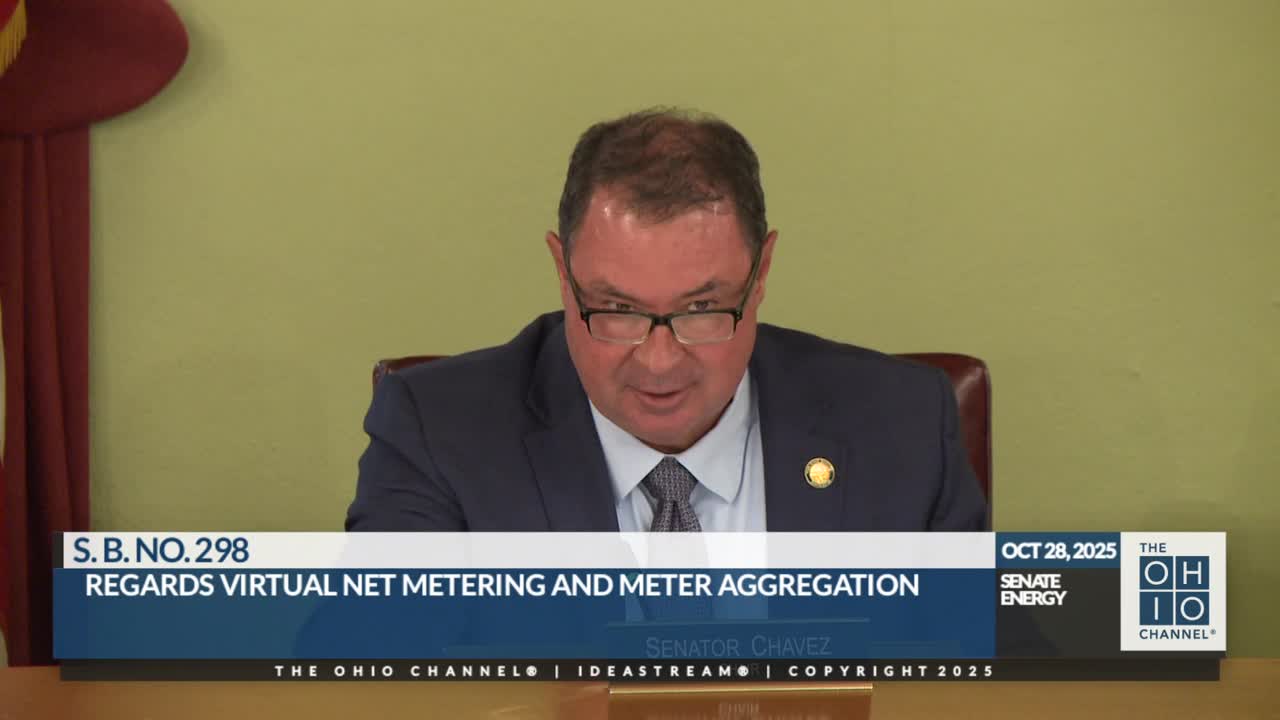Bill to expand virtual net metering for businesses would allow off-site projects on brownfields, but limit location to same utility territory
October 28, 2025 | Energy, Senate, Committees, Legislative, Ohio
This article was created by AI summarizing key points discussed. AI makes mistakes, so for full details and context, please refer to the video of the full meeting. Please report any errors so we can fix them. Report an error »

Senator Romanchuk presented sponsor testimony for Senate Bill 298 at the Senate Energy Committee, describing the measure as an update to prior legislation that would expand virtual net metering to commercial customers and allow off-site generation to supply businesses, schools and hospitals.
Romanchuk said the bill "opens market based opportunities for businesses to generate their own electricity" and would enable energy projects to be sited on brownfields, landfills and abandoned mine lands. He said the change would let businesses receive credit for electricity produced at connected off-site locations on the local distribution grid and could help direct investment to locations identified in state "heat maps."
Sponsors told the committee the bill includes provisions intended to prevent cost shifting to nonparticipating ratepayers. During questioning, Senator DeMora asked whether a business could expand an allocation if its needs grew after it connected. Romanchuk explained the bill allows a business to build generation off-site and noted that projects are typically sized based on current usage; "when they build the plant it's only 120% of their current usage of energy," he said, and a business would likely have to build an additional site if it sought more capacity.
Senator Wilkin asked whether the bill would require projects to be sited in areas identified on the heat maps or whether there are distance limitations from the customer's facility. Romanchuk said the bill does not require a business to build in a heat-map zone, but the legislation limits virtual net metered projects to the same utility territory in which the customer operates (for example, a customer in FirstEnergy territory could only place the off-site generation within FirstEnergy's service area). He emphasized that current law allows net metering only on a customer's property or adjacent land; the bill would extend that allowance to other sites inside the same utility territory, with an apparent focus on distressed properties.
Why it matters: Sponsors say the bill will increase private investment, use otherwise-unused distressed properties, and strengthen grid reliability by encouraging distributed generation where it is needed. Committee members raised concerns about allocation size, potential costs for transmission when projects are geographically distant, and safeguards to prevent nonparticipating customers from absorbing new costs.
The committee did not vote on Senate Bill 298; the bill received sponsor testimony and fielded several committee questions during its first hearing.
Romanchuk said the bill "opens market based opportunities for businesses to generate their own electricity" and would enable energy projects to be sited on brownfields, landfills and abandoned mine lands. He said the change would let businesses receive credit for electricity produced at connected off-site locations on the local distribution grid and could help direct investment to locations identified in state "heat maps."
Sponsors told the committee the bill includes provisions intended to prevent cost shifting to nonparticipating ratepayers. During questioning, Senator DeMora asked whether a business could expand an allocation if its needs grew after it connected. Romanchuk explained the bill allows a business to build generation off-site and noted that projects are typically sized based on current usage; "when they build the plant it's only 120% of their current usage of energy," he said, and a business would likely have to build an additional site if it sought more capacity.
Senator Wilkin asked whether the bill would require projects to be sited in areas identified on the heat maps or whether there are distance limitations from the customer's facility. Romanchuk said the bill does not require a business to build in a heat-map zone, but the legislation limits virtual net metered projects to the same utility territory in which the customer operates (for example, a customer in FirstEnergy territory could only place the off-site generation within FirstEnergy's service area). He emphasized that current law allows net metering only on a customer's property or adjacent land; the bill would extend that allowance to other sites inside the same utility territory, with an apparent focus on distressed properties.
Why it matters: Sponsors say the bill will increase private investment, use otherwise-unused distressed properties, and strengthen grid reliability by encouraging distributed generation where it is needed. Committee members raised concerns about allocation size, potential costs for transmission when projects are geographically distant, and safeguards to prevent nonparticipating customers from absorbing new costs.
The committee did not vote on Senate Bill 298; the bill received sponsor testimony and fielded several committee questions during its first hearing.
Don't Miss a Word: See the Full Meeting!
Go beyond summaries. Unlock every video, transcript, and key insight with a Founder Membership.
✓
Get instant access to full meeting videos
✓
Search and clip any phrase from complete transcripts
✓
Receive AI-powered summaries & custom alerts
✓
Enjoy lifetime, unrestricted access to government data
30-day money-back guarantee

